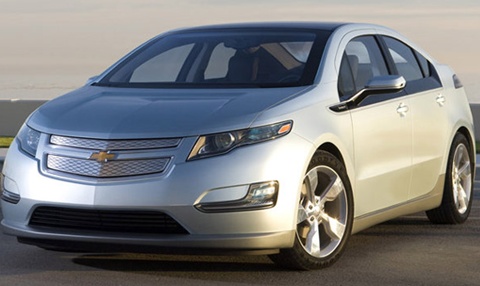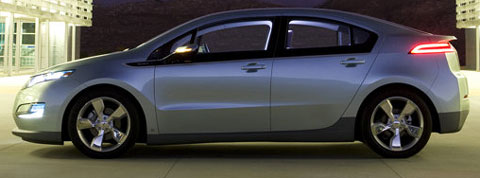The 2011 Chevrolet Volt was named the North American Car of the Year, it is not a hybrid car; nor is it electric car. The Chevy Volt ranks 2 out of 21 in the list of Upscale Midsize Cars based on 25 published reviews of reliability and safety data.
The Volt is unique that is closely compared to the its closest competitor, the Nissan Leaf. Comparatively speaking, the Chevy Volt is hard to match with other cars in the market.
Performance
The Chevy Volt’s exceptional electric power-train, provides 149 horsepower, which gives it an edge among other cars on the market. Overall reviews say that a Chevrolet Volt drive provide buyers satisfaction. Its 111 kilowatt electric motor and 16 kilowatt lithium-ion battery can deliver an electric power that can last travels between 25 and 50 miles. During trips, if the batteries’ power runs out, a 1.4-liter four cylinder gasoline motor kicks in keeping the Volt on the go. When the Volt goes over 70 mph, the motor also acts to add power to the wheels.
When a Volt is fully-charged and has a filled fuel tank, it can run for about 310 miles, the same range as that of a gas-only car. The Volt must be filled up in a gas station once every 300 miles. In contrast, a Nissan Leaf, which runs on purely electricity, is limited at a 100 mile range between charges. On the other hand, the Toyota Prius, though its travel distance is not near with the Chevrolet Volt’s, acquires a combined EPA fuel economy rating of 50 miles per gallon.
Charging the Volt would take about 10-12 hours from a 120 volt outlet; from a 240 volt outlet, charging will only take about four hours. However, charging would be of less concern because of its gasoline engine. Moreover, because of the Volt’s gasoline engine, its limitations are the same as any gasoline-powered car and operating it should be much less expensive than operating a gasoline-powered car since electricity is less expensive than gasoline. Despite the Volt’s acceleration and power, its low rolling resistance tires results to a harsh ride over rough pavement, plus its regenerative braking system will take some getting used to.
Exterior & Interior
The Chevrolet Volt has an exterior design dedicated for minimizing wind resistance and saving energy. Though it practically looks like any other hybrid car on the market, its features are not of the usual eco-friendly car. Some reviewers say that it looks better than a Prius.
The interior of the Chevy Volt is stylish and has a futuristic feel with well-engineered electronics, unique design and quality materials. Some have complained that only the two passengers in front will benefit from the ride. Generally, the Chevy Volt’s cabin is smaller compared to frontrunners since the battery pack is placed on the rear end of the car occupying the rear seat space.
Reviewers also mentioned that the Volt’s interior features work well along with Chevrolet’s technological innovation of cutting down the cabin technology’s energy consumption. The Leaf offers similar features as those of the Volt’s such as; a seven-inch high-resolution screen, which displays various information to the fancy of the car owner, a high-resolution touch screen control for features like the standard radio and the Bluetooth systems, and a six-speaker standard stereo Bose system that was intended to use minimal energy.
 The Volt also has a Smartphone application in which owners can manage their car battery packs like controlling charging times, a similar system with Nissan Leaf.
The Volt also has a Smartphone application in which owners can manage their car battery packs like controlling charging times, a similar system with Nissan Leaf.
The Competition
If you are looking for a car that can accommodate bulky or numerous cargos of a large family, the Chevy Volt is not for you. The 2011 Chevrolet Volt has a small cargo space of only 10.6 cubic feet in the rear, which is smaller than that of the Honda Civic (MSRP $15,805; 28 city / 36 hwy) and the Toyota Prius (MSRP $22,120; 51 city / 48 hwy).
Safety & Reliability
The federal government rated the Chevy Volt five out of five stars in the side and rollover tests, while four out of five stars in front crash tests. With these ratings and for receiving the scores of “Good” in front, rear and side impact crash tests and roof strength tests, the Volt is dubbed as a 2011 Top Safety Pick by the Insurance Institute for Highway Safety.
The standard safety features of the Chevy Volt include: stability and traction control; the OnStar service from GM to detect a crash or contact first responders even if the occupants are incapacitated; antilock brakes; twofold stage impact airbags located in front and on the sides for the driver and passenger in front; driver’s knee airbag; and backseat side-impact airbags. A promising feature of the Chevy Volt is its pedestrian alert feature, together with the American Federation of the Blind, was developed to sound a noise to alert pedestrians that the Volt is coming.
Though it is difficult to predict the reliability of the Volt on the streets, Chevrolet is offering generous warranty coverage for the buyers’ assurance that includes a five-year/100,000 mile warranty for the gas engine, a three-year/36,000-mile bumper-to-bumper warranty, five years/100,000 miles of courtesy transportation and roadside assistance and an eight-year/100,000 mile battery pack warranty.
Overall Rating
![]() 69 out of 100
69 out of 100
What others say:
“Especially in near-silent EV operation, the 2011 Chevy Volt certainly doesn’t provide the experience of a ‘regular’ car; but a quiet cabin, simple but well-put-together interior, and top-notch engineering make it very welcoming.”Car Connection
“Steering effort is consistently light, with a fairly precise but artificial feel. Body lean is well controlled, even during fast cornering. Braking feel is fine, though there’s a slight “let up” just before the car comes to a stop, requiring just a bit of added brake-pedal pressure.”Consumer Guide
“The 2011 Volt is essentially an electric car with a 1.4-liter gasoline engine to charge its Lithium-Ion battery when needed.”MSN Auto-ConsumerReports
“Questionable value; small backseat for two people only; touchy brakes; no power front seats; home charger is a necessity.”Edmunds
“If you are intrigued by the idea of an electric car but feel like their limited mileage range won’t fit your needs, the extended-range 2011 Chevy Volt is a perfect compromise between the EV you want and the gasoline-powered vehicle that more practically fits into your daily routine.”KBB
Specifications
| Vehicle Type: Hybrid Hatchback | Base Price: $31,645.00 |
| Fuel Tank Capacity: 9.3 gallons (35 liters) | MPG: 35 city / 40 hwy |
| Battery Range (Electric): 35 mi | EPA MPG Equivalent: 95 city / 93 hwy |
| Length: 177.1 in. (449 cm) | Width: 70.4 in. (178 cm) |
| Height: 56.6 in. (143 cm) | Wheel Base: 105.7 in. (268 cm) |
| Curb Weight: 3781 lbs (17175 kg) | Ground Clearance: NA |
| Luggage Capacity: 10.6 cu ft | Maximum Seating: 4 people |
| Engine: Electric-Gas Inline 4 | Displacement: 1.4 liters |
| Horsepower: 149 HP Electric | Torque: 273 lb-ft |
| Horsepower: 83 HP Gas | Transmission: Automatic |
| 0-60 mph: 8.9 seconds | 1/4 Mile: 16.7 seconds |





